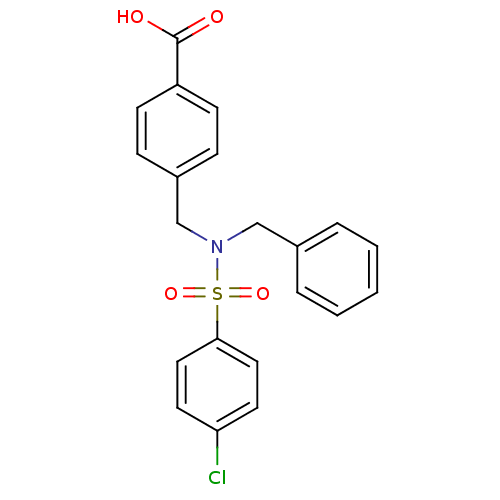

 Search and Browse
Search and Browse
 Download
Download
 Enter Data
Enter Data
BDBM50320146 4-((N-benzyl-4-chlorophenylsulfonamido)methyl)benzoicacid::CHEMBL1082389::US9247759, 5-120
SMILES: OC(=O)c1ccc(CN(Cc2ccccc2)S(=O)(=O)c2ccc(Cl)cc2)cc1
InChI Key: InChIKey=VOEXELGKQPYTIN-UHFFFAOYSA-N
Data: 2 IC50
| Target/Host (Institution) | Ligand | Target/Host Links | Ligand Links | Trg + Lig Links | Ki nM | ΔG° kcal/mole | IC50 nM | Kd nM | EC50/IC50 nM | koff s-1 | kon M-1s-1 | pH | Temp °C |
|---|---|---|---|---|---|---|---|---|---|---|---|---|---|
| chemokine (C-X-C motif) receptor 3 (Homo sapiens (Human)) | BDBM50320146 (4-((N-benzyl-4-chlorophenylsulfonamido)methyl)benz...) | UniProtKB/SwissProt antibodypedia GoogleScholar AffyNet | Purchase CHEMBL MCE PC cid PC sid UniChem Patents | Article PubMed | n/a | n/a | 2.94E+3 | n/a | n/a | n/a | n/a | n/a | n/a |
Merck Serono SA Curated by ChEMBL | Assay Description Antagonist activity at human CXCR3 expressed in mouse L1.2 cells assessed as inhibition of IP10-induced chemotaxis after 4 hrs | Bioorg Med Chem Lett 20: 3614-7 (2010) Article DOI: 10.1016/j.bmcl.2010.04.113 BindingDB Entry DOI: 10.7270/Q2668DDX | |||||||||||
| More data for this Ligand-Target Pair | |||||||||||||
| Taste receptor type 2 member 14 (Homo sapiens (Human)) | BDBM50320146 (4-((N-benzyl-4-chlorophenylsulfonamido)methyl)benz...) | UniProtKB/SwissProt GoogleScholar AffyNet | Purchase CHEMBL MCE PC cid PC sid UniChem Patents | US Patent | n/a | n/a | 394 | n/a | n/a | n/a | n/a | n/a | n/a |
Senomyx, Inc. US Patent | Assay Description In another embodiment, Fluorescence Polarization ("FP") based assays may be used to detect and monitor ligand binding. Fluorescence polarization is a... | US Patent US9247759 (2016) BindingDB Entry DOI: 10.7270/Q2V69HFW | |||||||||||
| More data for this Ligand-Target Pair | |||||||||||||